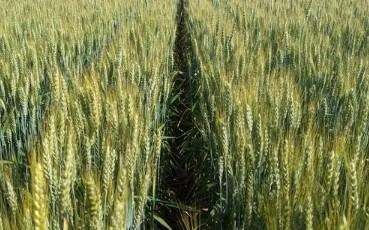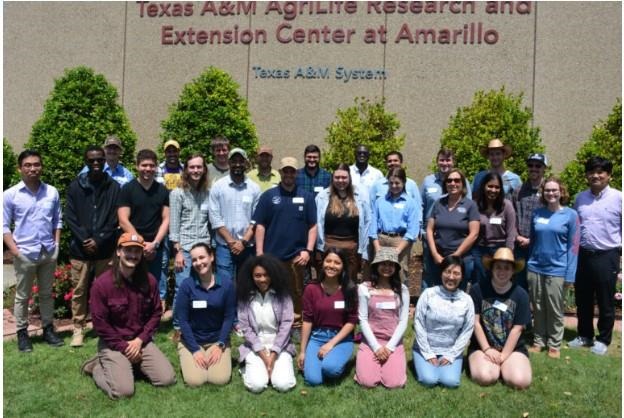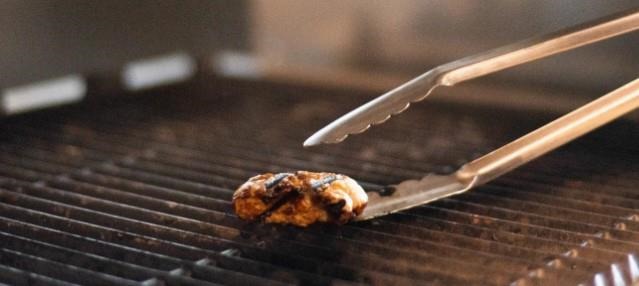Identification of the problem
Several species of beetles and moths can attack stored grain. The damaging life stages of beetles include larvae and adults, while damage from moth pests tend to be caused by larval stages. Proper identification of pests is essential for effective control. Some common stored grain pests are described at the end of this article. For assistance with insect identification, contact your local Extension Office. Penn State University offers a free insect identification service. Contact the Penn State Department of Entomology (814-865-1895) or the Penn State Plant Disease Clinic (814-865-7448) for information on how to submit a sample.
Preventive Measures Before Binning
Sanitation
The most effective way to manage stored grain pests is to avoid them. The goal of sanitation is to eliminate insect eggs, pupae, and adults. Never put newly harvested grain into bins containing old grain. Empty the bins of all residual grain, and use shovels, brooms, and industrial vacuums to clear dust, webbing, and fines from around any cracks and crevices, doors, seams, vents, and especially under false floors. Even small amounts of old grain or fines left in the bins can harbor insects that can start a problem. Clean fans, elevators, and other conveyors before new grain is stored. Grain that can harbor insects can collect in places that are difficult to see, such as on the top of stirrers. Once the bins are clean, inspect them and repair any cracks or holes which can allow moisture or insects to enter. Pretreat clean bins with an allowable grain protectant listed for pre-harvest space application. Always check with your organic certification agency before using new materials. Always wear proper safety equipment (e.g., respirator, air helmet) when cleaning and treating bins.
Clean combine headers, augers, conveyor belts and grain transporting equipment. Purge the first few bushels from the combine to remove old grain, and load harvested grain into a clean truck. Maintain weed- and spilled grain-free surroundings around grain storage.
Preventive Measures During Binning
Grain Cleaning
Fine materials, including insects and insect parts, have an affinity for moisture, mold, and insect infestations. Proper combine adjustment should be used to reduce the amount of grain breakage, fines, and foreign material. A grain cleaner can be used to improve storability. This is particularly important when storing wet, damaged, or immature grain. Grain cleaners include, but are not limited to:
Gravity Screens: These are simple cleaners which pass the grain over a screen during handling. Gravity screens can be stand-alone units that are fed from an auger conveyor or part of a permanent installation, such as at the output of a bucket elevator.
Perforated Auger: A section of the auger housing is perforated and as the grain is conveyed over the auger, the fines are separated. This type of cleaner has limited effectiveness when the auger is operated at 100% capacity. However, operating the auger at less than 100% capacity can result in increased grain damage.
Rotary Screen: The rotating screen tumbles and separates fines from grain. They can be very effective cleaners if properly sized and operated. Consult the manufacturer for specific operating instructions.
Aspirator Pre-Cleaners: Aspirators use airflow to remove dust, chaff, husks, awns and other material lighter than grain before it is dried. Grain is internally spread over the width of the aspirator chamber and the air is pulled through the cascading grain to remove materials lighter than the grain. The rate of airflow can be usually be adjusted to suit a variety of crops.
Preventive Measures After Binning
Monitoring Stored Grain
Facilities: Various kinds of traps are commercially available to monitor facilities for the presence of stored grain pests. Depending on the pest, lures may include female sex pheromones, male aggregation pheromones, or food attractants.
Temperature, carbon dioxide, and feeding damage are signs of insect infestation. Insects release heat as they respire, and at high insect densities, 'hot spots' can be created. Probe or permanent thermometers can provide grain temperature. However, hot spots can be very localized and difficult to detect, and insects can cause significant damage before they are detected.
Increased carbon dioxide concentration in the grain indicates the presence of insects in the storage bin during the development of the infestation. Monitoring tubes are placed into the top and in the center of the grain, and the air is sampled every 2 weeks.
Top of the grain mass: To determine if insects are present, inspect the top of the grain mass. A sour smell, grain clumped together, condensation on the inside surface of the bin roof, webbing on the grain surface, or the presence of insect larvae, adult beetles, or moths all indicate an insect infestation. An insect infestation on the surface of the grain mass and presence of webbing usually indicates Indianmeal moth. Because this insect only damages the upper 12-14" of the grain mass, removal of the webbing and damaged grain can reduce the infestation. If the grain was properly leveled and the grain surface treated (capped) with an allowable material after filling the storage structure, do not break or disturb the protective layer unless you can re-treat the surface. Pheromone traps are available to monitor for Indianmeal moth.
Interior of the grain mass: The interior of the grain mass can be monitored through the side access panel by using plastic tube traps, probe traps, and sticky pheromone traps. These traps are inserted into the grain mass for a specified period of time and then retrieved. These types of traps will attract insects and help determine the kind and number of insects present. A quick but less accurate method of sampling the grain mass for insects is by direct observation of grain removed from the side door using a grain probe. Deep probes should be collected from several locations in the bin and the collected grain placed in a container through which insects can be seen in the grain. These containers of grain should be placed in a warm area to allow the grain to warm to at least 60°F or higher to stimulate insect activity. Although there are no reliable thresholds for most insects found in stored grains, it is usually considered that if insects are found in a 1 quart sample of collected grain, the grain content of the bin should be quickly used before grain quality is diminished by insect activity.
Exclusion and Control of Insects in Stored Grain
Physical Methods
Physical exclusion: Use a small perforation bin floor to slow the build-up of fines beneath the floor. Stirrers cause fines that can harbor insect infestations to move down and collect at the bottom of the bin.
(Re)distributing grain in the bin: The top of the grain mass should be level to facilitate air flow. Improper leveling results in moisture wicking up and accumulating into the peaked grain mass. Even in bins with stirrers, fines can tend to concentrate in the center of the bin, potentially reducing air flow in the bin core and allowing hotspots to develop. The outside edges of the grain may appear to be dry, but the core of the grain mass may be moist, creating habitat that may harbor insect infestations and mold. To reduce settling of fines in the core of the bin in long-term storage, periodically remove grain from the bin core and redistribute it to the top of the bin.
Hermetic sealing or vacuum sealing to generate a low oxygen condition are allowable practices for organic grain storage. Oxygen levels of 1 to 2% are insecticidal to all major stored product insect pests when applied at common room temperatures for 1 to 4 days.
Temperature control and aeration: The use of low volume airflow rates to cool stored grains (aeration) is an important component of stored grain pest management. Airflow rates are usually specified as 0.1 to 0.5 cubic feet per minute (cfm) per bushel. Clean grain contributes to uniform airflow and successful drying. Because many stored grain pests originated in the tropics, they are susceptible to cold temperatures. Most require temperatures above 60oF to reach damaging populations; some need temperatures above 70°F. Therefore, storing grain in a cool place will slow pest development. Very cold temperatures can be used to kill pests; storage at 0°F for 4 days will destroy some species. Cooling the stored grain mass to 50 to 55°F causes insects infesting the grain to become inactive. Periods of warm fall temperatures increase the risk of late season insect infestations. In the spring, the grain mass should be warmed to a minimum of 60°F to prevent condensation of moisture on bin walls and subsequent damage from insects and mold. Follow aeration schedules specific to your area.
Heating can also be effective; exposure for 30 minutes at 130°F will kill many insect species. However, grains can crack, harden, and become brittle if heating is introduced too quickly or if excessive temperatures occur, and the germ could also be dam¬aged by extreme heat.
Low oxygen atmosphere: Insects need oxygen to survive. Carbon dioxide (CO2) or nitrogen (N2), both naturally-occurring gases, can be used as fumigants to create a low-oxygen atmosphere. Creating a low-O2 atmosphere requires specialized equipment and airtight containers, bins, or silos. CO2 or N2 gas is blown into the base of the bin or silo, forcing the existing, oxygen-rich air out of the top for two or more days. At 2% oxygen, adult insects cannot survive when maintained for 21 days with a grain temperature above 77°F. For grain below 77°F, this period is extended to 28 days. The O2 concentration in the bin or silo must be checked the day after fumigation and may need further purging to remove oxygen that has diffused from the grain.
Control Materials
The National Organic Program (NOP) allows or prohibits a material via the National List of Allowed and Prohibited Substances. This is a generic materials list. The NOP does not publish a brand name materials list. In organic production systems, synthetic materials cannot be used unless they are specifically approved, and natural materials can be used unless they are specifically prohibited. The National List specifies the allowed synthetic substances and prohibited non-synthetic substances along with specific restrictions, or annotations, regarding the source or use of the substance. The National List doesn't include numerous natural, non-synthetic, substances such as gypsum, limestone, or rock phosphate, which, as natural, mined materials, are allowed by definition. Certification agencies evaluate materials for compliance with the National List requirements. The use of a pesticide consistent with the National list is available for use only after preventative management, mechanical controls, or physical control methods have proved ineffective. Organic producers, processors, and handlers must submit a list of all inputs used or intended to use as part of the Organic System Plan, and the certification agency will determine if the substances are allowed for organic production, storage, or handling. Some active ingredients have different formulations for organic and conventional production. Make sure that both the active ingredient and the formulation are allowed in organic systems. The use of some control materials may be restricted, and may only be used after all preventive measures have failed.
Wear the appropriate protective clothing and equipment when using or handling pest control materials to help avoid exposure to eyes, lungs, and skin. Keep unprotected persons out of treated areas until sprays have dried. Avoid development of resistance by using an IPM approach. Insecticides, even natural ones, used repeatedly as the primary method of control for targeted species may result in partial or total loss of control of those species. Always check with your organic certification agency before adopting new practices or using new materials or materials in a new way.
Some insect control materials allowed in organic stored grains
Bacillus thuringiensis (B.t.). B.t. is a bacterium that can be used in empty grain bins or as a top-dress to prevent or control moth pests such as Indianmeal moth. Allowable formulations of B.t. can be used during grain storage to kill moth caterpillars that hatch after the grain is stored. B.t. is effective only against the larval stage of moths, such as grain moths and Indianmeal moths. Eggs, pupae, and adults are not affected, and the product must be ingested by caterpillars to work. B.t. kills caterpillars by damaging their digestive tract over a period of two or more days. Not all B.t. products are formulated for organic systems.
Diatomaceous earth (DE, silicon dioxide): DE is made from fossilized aquatic organisms called diatoms whose skeletons are made of silica. DE products contain mined diatom sediments ground into a dust. The sharp edges of DE cut the pest's cuticle, resulting in death by dehydration.
Grain surface protectant/treatment. Clean the empty grain storage area of grain debris, then dust the bin walls, ceilings and floors through the fan system. Fill bins only to the height of side walls and level the grain before applying allowable surface or top-dress treatments to fresh grain to prevent invading insect infestations, especially Indianmeal moth. Top dressing or capping the grain in the bin will act as a protective barrier from migrating insects which enter the bin from the top. Check product labels for application rates. To manage invading insects, re-apply at monthly intervals upon their first appearance. In cases of severe infestation by moths, break up webbing on the grain surface before dusting and apply a second application within two weeks.
Pyrethrum. Pyrethrum is a broad-spectrum, botanical insecticide produced from flowers of the chrysanthemum plant family. Pyrethrum is primarily a contact poison and rapidly penetrates the external covering of insects. It is non-persistent and decomposes rapidly in the sunlight. For best results treat the bin when it is empty of product, to the grain as a protectant as it is put into storage, and as a surface spray once it is in storage.
Biological Control
Biological control is the use of predatory or insect-parasitic insects or microbes to control pests. Several species of beneficial insects that attack the major pest insects in stored grain, including granary weevil, rice weevil, maize weevil, rusty grain beetle, lesser grain borer, confused flour beetle, sawtooth grain beetle, Angoumois grain moth, and Indianmeal moth are commercially available. Limitations to this approach include expense, potential negative effects of grain protectants on biological control agents, and presence of live beneficial insects and insect parts in the grain
Grain Rescue
If infestations of various flour beetles, grain weevils, or other stored grain beetles are found infesting the cold grain mass, then the immediate use of grain for livestock feed or some other use where insects do not cause problems in the end product is recommended. The grain should be fed to livestock prior to warmer temperatures when insect activity increases.
In summary, there are viable alternatives to insecticides for managing pests of organic stored grains. These include sanitation, monitoring, controlling temperature, carbon dioxide fumigation, and diatomaceous earth, and biological control. Integrating these preventive and intervention methods can contribute to reducing insect problems in organic stored grains. Always check with your organic certification agency before adopting new practices or using new materials.
Some Common Stored Grain Pests
Stored grain pests are of two broad types – “internal feeders" that feed within the grain kernel, and “external feeders" which feed on grains without entering the kernel. External feeders are sometimes referred to as “secondary feeders" and infest bins because of the presence of grain dusts, cracked or broken grains, and grain debris, including on the dusts and damaged kernels created by internal feeders. These pests can feed throughout the grain mass or be localized, such as in the core of the bin where fines collect at binning. Examples of common internal feeders include the granary weevil, the lesser grain borer, and the Angoumois grain moth. Examples of common external feeders include the Indianmeal moth, the sawtoothed grain beetle, and the red and confused flour beetles.
Internal Feeders
Granary Weevil, Sitophilus granarius
The granary weevil is among the most destructive of all stored grain insects. The larvae develop inside kernels of whole grain in storage, thus making an infestation difficult to detect and to remove in the milling process. The granary weevil is a pest of stored corn, barley, wheat, oats, rice, beans, and other dried and stored foods, especially in elevators, mills, and bulk storages. They are transported within grain as eggs, larvae or pupae. They can readily spread in grain residues. Adults can be found wandering over the surface of grain, especially if the grain has been disturbed. A sign of their presence is exit holes in infested grains. In warm weather, the granary weevil can develop from egg to adult in about five weeks. Cold weather prolongs development.
Pitfall traps placed on the grain surface and probe traps inserted into grain bins can be used to detect adult weevils. Larval stages in the grain may be detected using hidden infestation detection techniques. These can involve squashing the grain against indicator papers or testing for changes in grain specific gravity.
Adults: Granary weevil adults have a long, slender “snout" and elbowed antennae characteristic of the weevil family. Adults are chestnut-brown or reddish-brown to shiny black, and are about 1/5" in length. The body is sparsely covered with short, stout yellow hairs. Adults do not have wings, and cannot fly but are very active walkers. Adults cannot usually infest crops in the field before harvest. Adults live for 7 to 8 months, and can survive for a month or more without food in cooler conditions.
Eggs, Larvae, and Pupae: These stages are not normally seen as they occur inside intact grains. Females usually lay around 50 to 200 white eggs throughout their lives. The female lays eggs individually in cavities that she bores in the grain kernels and seals with a waxy egg plug. Eggs incubate for about 4-14 days before hatching, depending on temperature and humidity. One white, legless larva develops in each infested kernel, feeding until only the hull remains. The larva develops into a naked white pupa and pupates inside the grain. The newly emerged adult chews its way out of the grain, leaving a characteristic exit hole. In warm conditions the life cycle can be completed within 4 to 6 weeks, but can take as long as 17 to 21 weeks in the winter.

Granary weevil on wheat. Clemson University - USDA Cooperative Extension Slide Series, Bugwood.org
Rice Weevil, Sitophilus oryzae and Maize Weevil (Greater Grain Weevil), Sitophilus zeamais
The rice and maize weevils are similar to the granary weevil in appearance and behavior. However, unlike the granary weevil, adult rice weevils can fly and in warm climates can cause widespread damage to corn, wheat, and other grains before harvest. Maize weevil is more likely than rice weevil to fly to a ripening crop in the field and establish an infestation in the grain before harvest. However, in temperate areas, post-harvest infestations are most common and originate from shipped-in grain or from already infested stored grains. Both are able to develop on a wide range of cereals and also on processed cereal products. However, maize weevil is predominantly found associated with corn grain, whereas rice weevil is often associated with wheat. Disturbance of the grain causes adult rice and maize weevils to migrate upwards and become visible on the surface of the grain mass.
Adults: Rice weevils and maize weevils are almost indistinguishable from each other. Both have the characteristic snout and elbowed antennae of the weevil family. Adult rice and maize weevils are usually dull red-brown to black with four pale reddish-brown or orange-brown oval marking on their backs. Maize weevil adults are usually darker in color and shinier than rice weevils. The adults are long-lived (several months to one year) and can be found wandering over the surface of grain. Both of these weevils have fully developed wings beneath their wing covers and can fly readily.
Eggs, Larvae and Pupae: These stages are all found within tunnels and chambers in the grain and are not normally seen. Adult rice weevils live for four to five months and each female may lay up to 300 to 400 eggs individually in cereal grains. The eggs are shiny, white, opaque and ovoid to pear-shaped, and larvae are white and legless. Two rice weevils may develop at the same time on two sides of a single kernel. The pupa is also white but has legs, wings, and the snout of the fully-grown weevil. After pupation, the newly developed adult chews its way out of the grain, leaving an emergence hole with irregular edges.

Rice Weevil. Clemson University - USDA Cooperative Extension Slide Series, Bugwood.org

Maize weevil. Gary Alpert, Harvard University, Bugwood.org
Lesser Grain Borer, Rhyzopertha dominica
This pest is most common in warm climates but can spread to any area in transported grain. Both adults and larvae cause considerable damage. Adults have very powerful jaws and can bore into intact kernels. They fly readily, can be carried by air currents, and have been trapped using pheromone-baited flight traps several miles from any food storage or processing facility. Adults and larvae feed primarily on stored cereal seed including wheat, maize, rice, oats, barley, sorghum and millet.
The simplest method to detect lesser grain borer is to sieve a sample of the grain and look for adults. However, this method will not detect larvae, pupae and adults inside the grain kernels. Adults can be detected by placing probe pitfall traps in the grain. The traps are left in the grain and inspected periodically. Traps should be left in place for 2-7 days and are ineffective at temperatures below 50°F, when the insects stop moving. Pheromone-baited flight traps are a highly sensitive tool for the detection of adults. Like probe pitfall traps, flight trap catches are a relative measure and are temperature dependent, with few insects being caught at air temperatures below 68°F.
Adults: Adults are 1/8" in length, reddish-brown to black, and cylindrical. The head is not visible from above, and the pronotum (front of the body) has rasp-like teeth. The adults damage grain by boring into the kernels and leaving them covered with powder from the chewed material. Females lay between 200 and 500 eggs in their lifetime. The eggs are laid loose in grain or in the dust created by the insect.
Eggs, Larvae, and Pupae: Eggs are typically white when first laid, and turn pink to brown before hatching. The larvae are mobile and develop inside the kernels of whole grain. Development is more rapid on whole grain than on meal made from the same grain. Young larvae cannot penetrate undamaged kernels. Pupation takes place in grain.

Lesser grain borer. Pest and Diseases Image Library, Bugwood.org

Lesser grain borer on wheat. Clemson University - USDA Cooperative Extension Slide Series, Bugwood.org
Angoumois Grain Moth, Sitotroga cerealella
This is a common and destructive pest of crib ear corn, stored shelled corn, and other small grains, but attack is confined to the surface layer of grain. Field infestations are common in some areas, but it is sensitive to cold temperatures and not common in the northern US. The larvae develop within the grain kernels. Because the larvae stay in the same grain throughout their development, infestations in bulk grain are usually confined to the outermost exposed layers. In temperate climates, Angoumois grain moth overwinters in the larval stage in stored grain kernels or in scattered wheat, in litter, straw piles or baled straw. The adults emerge in May.
Adults: The moth is small, pale brown, with a wingspan of about ½". The forewings are clay-yellow and without markings; the hindwings are gray. The rear edges of the forewings and hindwings are fringed. Adults are short-lived (about 7 days) and do not feed. Adults are strong fliers and cross-infestation occurs easily. However, they are also delicate and cannot penetrate far into closely packed grain.
Eggs, Larvae, and Pupae: The eggs are laid singly or in clumps of variable numbers. The female deposits 80 to 200 eggs on the outside of the kernel, or in grooves or holes made by other insects. The newly hatched larvae bore into the kernel. Larval infestation initially leaves no visible signs on the grains because larval development occurs within a single grain. Young larvae are white except for their head which is dark. Full-grown larvae are about 1/8" in length and are usually yellowish white with a yellowish brown head. Two or three larvae may develop on a kernel of corn, but only one adult can be produced from other grains. Before pupation, the larva constructs a chamber just below the grain seed coat, forming a small, circular, translucent 'window'. The pupal case can be reddish brown to nearly black. The newly emerged adult pushes through the window of the seed coat, leaving a small, round hole, usually in the crown end of the grain.

Angoumois grain moth, multiple stages. Clemson University - USDA Cooperative Extension Slide Series, Bugwood.org
External Feeders
Sawtoothed Grain Beetle, Oryzaephilus surinamensis.
The saw-toothed grain beetle is one of the most common pests in grain bins, but also occurs in elevators, mills, processing plants, warehouses, and kitchens. In grain bins, it feeds on broken kernels and grain residues. The larvae develop in flour, cereal products, and many other dried foods.
Adults: Adults are about 1/10" long. The body is very flat and is well adapted for crawling into cracks and crevices. The margins of the thorax are saw-like and possess six projections on each side. Wings are well developed but there is no record of this insect flying. Adults are generally very active and tend to migrate from the food source when populations become too large.
Eggs, Larvae, and Pupae: Females produce 375 eggs on average. Eggs are deposited singly or in small masses in the food. Sawtoothed grain beetle larvae are yellowish white except for their head, which is brown. Full grown larvae are less than 1/8" in length. In preparation for pupation, the larva attaches itself to a fixed object. The pupa forms in a cell made of food particles. The larval exoskeleton is shed but remains attached in the pupal cell. The pupa has the same six projections on each side of the thorax as the adult.

Sawtoothed grain beetle. Emilie Bess, USDA APHIS PPQ, Bugwood.org
Red (Tribolium castaneum) and Confused (Tribolium confusum) Flour Beetles.
These beetles are two of the most important pests of stored products in the home and grocery stores, and are similar to the saw-toothed grain beetle in habits and types of products infested. In the US, the confused flour beetle is more common than the red flour beetle in the northern states. The red and confused flour beetles may be present in large numbers in infested grain, but are unable to attack sound or undamaged grain They are serious pests in flour mills and wherever cereal products and other dried foods are processed or stored. These beetles can also be found in cracks and crevices where grain may have spilled. They are attracted to grain with high moisture content and can cause a grey tint to the grain. The beetles give off a bad odor that affects the taste of infested products, and their presence encourages mold growth in grain.
Adults: Adult beetles are about 1/8" in length, and may live for more than three years. The red flour beetle may fly, especially before a storm, but the confused flour beetle does not fly. The adults are attracted to light, but will go towards cover when disturbed.
Eggs, Larvae, and Pupae: The eggs are white, microscopic and often have bits of flour stuck to their surface. The slender larvae are creamy yellow to light brown in color. They have two dark pointed projections on the last body segment.

Confused flour beetle. Pest and Diseases Image Library, Bugwood.org
Indianmeal Moth, Plodia interpunctella
These moths are common pests of both stored grain and cereal products, and larvae cause damage in meal, packaged foods, bagged grain, and grain in storage. Damage is usually confined to surface layers of stored shelled corn and small grains, but larval feeding occurs anywhere because the moths crawl to lay their eggs. Infestations of this moth are characterized by abundant webbing of the infested material. The larvae are surface feeders. Most of the damage to stored products occurs when the larvae spin massive amounts of silk that accumulate fecal pellets, cast skins, and egg shells in stored products. The damage to stored products due to this contamination exceeds the amount of food eaten by the insects.
Adults: Adults moths are 3/16 – 7/16" long and have an average wing span of about 11/16". The lower two thirds of the fore wings are reddish bronze with a coppery sheen and irregular dark bands. The upper one third is silvery white or gray. Hind wings are silvery gray with a long fringe of hairs. Adults are generally short lived (about 7 days) and do not feed.
Eggs, Larvae, Pupae: A single female can lay up to 400 eggs after mating. The grayish-white eggs of the Indianmeal moth are deposited singly or in clusters, and are generally laid directly on the larval food source. Upon hatching, the larvae begin to disperse and within a few hours can establish themselves in a food source, leaving a silky thread behind. Young larvae are white except for their head, which is dark. Full-grown larvae are usually yellowish white, greenish white, or pinkish. Mature larvae are about ½" in length. The mature larvae often leave the infested material and crawl about in search of a place to pupate. The larvae pupate either in a silken cocoon or unprotected. The pupae are 1/4 to 2/5" and are pale brown in color.

Indian meal moth. Pest and Diseases Image Library, Bugwood.org

Indian meal moth larva and pupae. Whitney Cranshaw, Colorado State University, Bugwood.org
Source : psu.edu